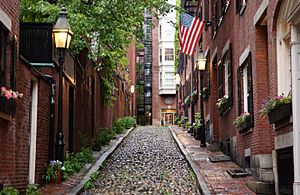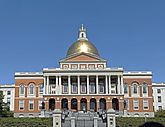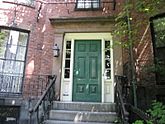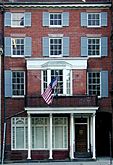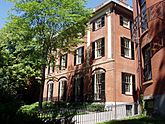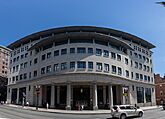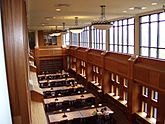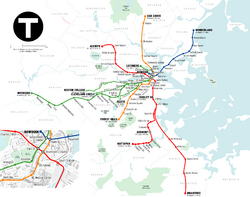Beacon Hill, Boston facts for kids
|
Beacon Hill Historic District
|
|

Park Street, looking toward the Massachusetts State House
|
|
| Lua error in Module:Location_map at line 420: attempt to index field 'wikibase' (a nil value). | |
| Location | Boston, Massachusetts |
|---|---|
| Built | 1795 |
| Architect | Charles Bulfinch |
| Architectural style | Colonial Revival, Greek Revival, Federal |
| NRHP reference No. | 66000130 |
Quick facts for kids Significant dates |
|
| Added to NRHP | October 15, 1966 |
| Designated NHLD | December 19, 1962 |
Beacon Hill is a famous old neighborhood in Boston, Massachusetts, United States. It's also the name of the hill where the Massachusetts State House (the state government building) stands. People in Boston sometimes use "Beacon Hill" to mean the state government itself, much like "Capitol Hill" refers to the U.S. government.
This neighborhood is known for its beautiful Federal-style rowhouses. It has narrow streets lit by old-fashioned gas lamps and sidewalks made of brick. Beacon Hill is considered one of Boston's most desirable and expensive places to live. In 2010, about 9,023 people lived here.
Why is it called Beacon Hill?
The neighborhood gets its name from a beacon (a signal light) that once sat on the highest point of central Boston. This beacon was used long ago to warn people if an invasion was coming.
Where is Beacon Hill located?
Beacon Hill is surrounded by Storrow Drive, Cambridge Street, Bowdoin Street, Park Street, and Beacon Street. It's about one square mile in size. The neighborhood is next to the Charles River Esplanade on the west side. It's also just north of Boston Common and the Boston Public Garden.
Beacon Hill has three main parts:
- The south slope
- The north slope
- The "Flat of the Hill," which is a flat area built on landfill (land created by filling in water). This part is west of Charles Street, between Beacon Street and Cambridge Street.
This area was originally part of the Shawmut Peninsula and had three hills: Beacon Hill, Pemberton Hill, and Mount Vernon. The last two hills were flattened to make space for building. The name "trimount" (meaning three hills) later became "Tremont," as in Tremont Street. Between 1807 and 1832, Beacon Hill itself was lowered from 138 feet to 80 feet tall. This project, along with filling in parts of the shoreline, greatly increased Boston's land area. Charles Street was one of the new roads created during this time.
Who lives in Beacon Hill?
In 2010, about 9,023 people lived in Beacon Hill. This was a small decrease from 2000. Most residents (86.8%) are white. Other groups include Asian (5.3%), Hispanic or Latino (4.1%), and Black or African American (2%).
The neighborhood has many different types of households. About 27% are family households, and 72% are non-family households. Many families are married couples, some with children under 18.
What is the history of Beacon Hill?

Early Days (1600s)
The first European to settle here was William Blaxton in 1625. He built a house and planted an orchard on the south side of Beacon Hill. In 1630, the Massachusetts Bay Company settled Boston. The city used the southwest slope of the hill for military training and for animals to graze. A signal beacon was put on top of the hill in 1634.
During the 1600s and 1700s, sailors and British soldiers often visited the north side of Beacon Hill. This made it a less popular area for other Boston residents at the time.
Growing Up (1700s)
Beacon Street was created in 1708 from an old cow path leading to the Boston Common. A famous painter, John Singleton Copley, owned land on the south slope where he kept cows and farmed.
In 1787, Charles Bulfinch designed the Massachusetts State House. It was finished in 1795 and became the new home for the state government, replacing the Old State House.
As Boston grew, more space was needed. In 1795, a group called the Mount Vernon Proprietors bought land west of the State House. Charles Bulfinch helped plan the new neighborhood. A few years later, parts of the hills were leveled, and streets like Mount Vernon Street were built. Grand homes, like the Harrison Gray Otis House, were among the first to be built.
Building Boom (1800s)
New Homes and Styles
Many homes were built in the early 1800s. These included large, stand-alone mansions, pairs of matching houses, and row houses (houses built in a row that share side walls). The first row houses were built around 1803-1805.
-
Harrison Gray Otis House, a mansion on Cambridge Street
-
A pair of houses at 54-55 Beacon Street. The house on the left is known as the William H. Prescott House.
By the 1830s, many wealthy people built homes on Chestnut and Mt. Vernon Streets. Later in the 1870s, some rich families moved to Back Bay. This area had wider streets and larger, brighter homes with mansard roofs.
South Slope: Wealthy Families
The south slope of Beacon Hill became a place for Boston's wealthiest and most powerful families. These families, sometimes called the Boston Brahmins, were known for their beautiful homes, their focus on helping others, and their strong Unitarian faith. Many important writers and thinkers lived here, including Daniel Webster, Henry Thoreau, and Wendell Phillips.
Flat of the Hill: Shops and Homes
Development on the "Flat of the Hill" also started in the early 1800s. Many single-family homes here had shops on the first floor, for people like retailers, carpenters, and shoemakers. Today, some old buildings like the Charles Street Meeting House are far from the water. This is because so much land was filled in over the years.
North Slope: African American Community
The north slope of Beacon Hill was home to African Americans, sailors, and immigrants from Eastern and Southern Europe. The area around Belknap Street (now Joy Street) became a strong community for over 1,000 Black residents starting in the mid-1700s. This community was well-established even before the south slope became a wealthy area.
Many Black residents attended church with white people but had separate seating and no vote in church matters. The African Meeting House was built in 1806 and became a key place for Black abolitionists (people who wanted to end slavery). Famous speakers like Frederick Douglas spoke there, and the New England Anti-Slavery Society was formed at the Meeting House. It was also an important stop on the Underground Railroad, a secret network that helped enslaved people escape to freedom.
Both Black and white residents in Beacon Hill strongly supported the anti-slavery movement. After the Civil War, many Black residents moved to other Boston neighborhoods like Roxbury and the South End.
New Immigrants
In the late 1800s, many Irish, Jewish, and other immigrants moved to Beacon Hill. Many older brick and wood homes were replaced with new brick apartment buildings. Some homes were also turned into boarding houses.
As Black residents moved out, Eastern European Jews moved into the north slope. The Vilna Shul (a synagogue) was built in 1898, and the African Meeting House was even used as a synagogue for a time.
Modern Times (1900s and 2000s)
In the early 1900s, better transportation helped Boston's economy grow. New buildings were constructed, and old ones were fixed up. To protect the neighborhood's look, the Beacon Hill Association was formed in 1922. They worked to keep the brick sidewalks and prevent too much new construction.
The "Flat of the Hill" changed as banks, restaurants, and other businesses moved in.
In the 1950s, people wanted to renovate the area. To protect its historic buildings, residents worked to get Beacon Hill recognized as a historic district. The south slope became a historic district in 1955, the Flat of the Hill in 1958, and the north slope in 1963. The Beacon Hill Architectural Commission was created in 1955 to oversee building projects. For example, in 1963, a building was saved from demolition by keeping its exterior and building new apartments inside.
Beacon Hill was named a National Historic Landmark on December 19, 1962. This means it's a very important historic place in the United States.
Today, wealthy families still live in the Flat of the Hill and south slope. The north slope is home to students from Suffolk University and other professionals.
What can you see and do in Beacon Hill?
Black Heritage Trail
The Boston African American National Historic Site is just north of Boston Common. This trail includes historic buildings that were homes, businesses, schools, and churches for the Black community. The Charles Street Meeting House was built in 1807. The Museum of African American History is located at the African Meeting House. This meeting house is the oldest Black church built by African Americans that is still standing. You can also see the Robert Gould Shaw Memorial and the 54th Massachusetts Regiment Memorial near the State House.
Massachusetts State House
The Massachusetts State House, on Beacon Street, is where the state government works. This building, with its famous gold dome, was designed by Charles Bulfinch and finished in 1798. Many other state capitol buildings in the country were designed to look like it.
Local Groups
Community Groups
The Beacon Hill Civic Association has been helping the neighborhood since 1922. It was started to stop new construction and protect the area's unique character. Today, this volunteer group works to improve life in the neighborhood. They helped get resident parking permits and worked to preserve Beacon Hill as a historic district.
Other Organizations
The Club of Odd Volumes on Mount Vernon Street is a historic club for book lovers. The Headquarters House (also called the William Hickling Prescott House) is a museum run by the Society of Colonial Dames. The Boston Bar Association, the oldest legal group in the country, is on Beacon Street. Beacon Hill Village was the first formal "Elder Village" in the U.S., helping older residents stay in their homes.
-
The Club of Odd Volumes at 77 Mt. Vernon Street
-
The Chester Harding House, once home to painter Chester Harding, now houses the Boston Bar Association.
Churches and Religious Groups
Religious places include the Vilna Shul, an Orthodox Jewish synagogue, and the Unitarian Universalist Association headquarters. The Church of the Advent is a beautiful Victorian Gothic church. The Park Street Church, sometimes called "Brimstone Corner," was used to store gunpowder during the War of 1812. The song America the Beautiful was first sung here in 1831.
Neighborhood Features
Beacon Hill is mostly residential, known for its old colonial brick row houses. These homes have lovely doors, decorative ironwork, brick sidewalks, narrow streets, and gas lamps. You can find restaurants and antique shops on Charles Street.
Louisburg Square is considered the most famous address in Beacon Hill. Residents there have access to a private park and live in grand Greek Revival townhouses. Nearby is Acorn Street, often called the "most photographed street in the United States." It's a narrow lane paved with cobblestones, where coachmen for wealthy families once lived.
-
The Second Harrison Gray Otis House at 85 Mount Vernon Street.
The Harrison Gray Otis House on Cambridge Street was built in 1796. Charles Bulfinch designed this house for Harrison Gray Otis, a businessman who helped develop Beacon Hill. This house is also the headquarters for Historic New England, an organization that preserves historic places. Other notable homes include the Francis Parkman House and the Nichols House Museum, which shows what life was like for a wealthy family.
Suffolk University
Suffolk University and its Law School are located next to the Massachusetts State House and the Massachusetts Supreme Judicial Court. The Law School was founded in 1906.
How to get around Beacon Hill?
You can reach Beacon Hill using the Massachusetts Bay Transportation Authority (MBTA) subway stations:
- Park Street – on the Red and Green Lines
- Bowdoin – on the Blue Line
- Charles/MGH – on the Red Line
Other public transportation options like MBTA buses and MBTA commuter rail are also available.
Famous people from Beacon Hill
Many well-known people have lived in Beacon Hill, including:
- Louisa May Alcott, author of Little Women
- William Blaxton, the first European settler
- Charles Bulfinch, famous architect
- John Singleton Copley, painter
- Michael Crichton, author
- Robert Frost, poet
- John Hancock, American patriot
- Oliver Wendell Holmes Sr., writer
- Oliver Wendell Holmes Jr., Supreme Court Justice
- Julia Ward Howe, writer of "The Battle Hymn of the Republic"
- Edward M. Kennedy, U.S. Senator
- John Kerry, U.S. Secretary of State
- Sylvia Plath, poet
- Carly Simon, singer-songwriter
- Uma Thurman, actress
- Daniel Webster, famous statesman
Beacon Hill in books and movies
- The book The Late George Apley (1937) makes fun of the upper-class residents of Beacon Hill.
- The Cheers TV show used the outside of the Bull and Finch Bar on Beacon Street as inspiration for its famous bar.
- Make Way for Ducklings (1941) is a popular children's picture book about ducks. Much of the story happens at the foot of Beacon Hill. Every May, there's a parade through Beacon Hill to celebrate the book.
- The 1968 movie The Thomas Crown Affair was filmed in and around Beacon Hill.
- The writer Robert Lowell wrote about his childhood home on Beacon Hill in his story 91 Revere Street.


